天池幸福感的數據處理
In these exceptional times, the lockdown left many of us with a lot of time to think. Think about the past and the future. Think about our way of life and our achievements. But most importantly, think about what has been and would be our contribution to the world. And, as I was seeking for inspiration and energy, I decided to grasp the question of happiness and get a deeper understanding of the complex nature of its dynamics.
在這些特殊時期,封鎖使我們許多人有很多時間去思考。 考慮過去和未來。 想一想我們的生活方式和成就。 但最重要的是,考慮一下我們將對世界做出的貢獻,并將為之做出貢獻。 而且,當我尋求靈感和能量時,我決定抓住幸福的問題,并更深刻地了解幸福的復雜性。
What makes people truly happy?
是什么使人們真正快樂?
We all have our own ideas about happiness and its key determinants. Some would choose wealth as it is indispensable to enjoy a comfortable like with high living conditions. Some would reject this materialistic point of view and would argue that social relationships (family, friends, etc.) and values are what matters the most. Others would defend the idea that, as citizens who benefit from a set of rights while abiding by certain rules, it’s the government and its policies that really determine our living conditions and thus our happiness.
我們都對幸福及其主要決定因素有自己的看法。 有些人會選擇財富,因為像高生活條件這樣的舒適享受是必不可少的。 有些人會拒絕這種唯物主義的觀點,并認為社會關系 (家庭,朋友等)和價值觀才是最重要的。 其他人會捍衛這樣的觀點,即公民在遵守某些規則的同時從一系列權利中受益,真正決定我們的生活條件并因此決定我們的幸福的是政府及其政策 。
These are all intuitive ideas. But what does the available data tell us?
這些都是直覺的想法。 但是可用數據告訴我們什么?
In this perspective, I analyzed data from The World Happiness Report which is a landmark survey of the state of global happiness. More specifically, it contains, on the one hand, happiness scores based on the answers gathered from the Gallup World Poll (GWP) and on the other hand, indicators of economic production, social support, life expectancy, freedom, absence of corruption, and generosity.
從這個角度來看,我分析了《世界幸福報告》中的數據, 該報告是對全球幸福狀況的里程碑式調查。 更具體地說,它一方面包含根據蓋洛普世界民意調查 (GWP)收集的答案得出的幸福分數,另一方面則包含經濟生產,社會支持,預期壽命,自由,沒有腐敗以及大方。
In a series of three articles, I will share with you my key findings. The first article intents to give a general overview of the evolution of happiness and related indicators across countries through a data explanatory analysis. The two others focus on the causal impact of these indicators on happiness.
在三篇文章中,我將與您分享我的主要發現。 第一篇文章旨在通過數據解釋性分析來概述各國幸福感的發展及相關指標。 另外兩個重點關注這些指標對幸福的因果影響。
Structure:
結構體:
About the Data
關于數據
General Overview of Happiness
幸福概述
Happiness & Wealth
幸福與財富
Happiness & Social Environment
幸福與社會環境
Happiness & Public Policies
幸福與公共政策
1.關于數據 (1. About the Data)
First, let’s start by defining the key indicators that will be used. The data taken from the World Happiness Report is particularly interesting as it combines fundamental economic with more subjective social measures.
首先,讓我們開始定義將要使用的關鍵指標。 《 世界幸福報告 》中的數據特別有趣,因為它結合了基本經濟和更主觀的社會措施。
Economic indicators
經濟指標
GDP per capita: in terms of Purchasing Power Parity (PPP) adjusted to constant 2011 international dollars, from World Development Indicators (WDI), 2018.
人均GDP :根據2018年《 世界發展指標》(WDI) ,按購買力平價(PPP)調整為2011年恒定國際美元。
Healthy life expectancy at birth: from the World Health Organization (WHO) Global Health Observatory data repository.
出生時的健康預期壽命 :來自世界衛生組織(WHO) 全球衛生觀察站數據庫。

Happiness measures
幸福措施
These indicators mainly come from the Gallup World Poll (GWP). It continually surveys residents in more than 160 countries using randomly selected, nationally representative samples. Typically, a set of questions is asked to 1,000 individuals in each country during interviews conducted face-to-face or by phone. For more information, you can read this article.
這些指標主要來自G allup世界民意測驗(GWP)。 它使用隨機選擇的,具有全國代表性的樣本不斷調查160多個國家/地區的居民。 通常,在面對面或通過電話進行的訪談中,會向每個國家的1,000個人提出一系列問題。 有關更多信息,您可以閱讀本文 。
The main challenge of studying happiness is, first, how to measure it. In fact, the assessment of well-being goes from general judgments of life (life evaluation) to feelings (daily affect). In this context, we will be using 3 metrics:
研究幸福的主要挑戰是,首先,如何衡量幸福。 實際上,對幸福感的評估從對生活的一般判斷(對生活的評估)到對感覺(每天的影響)的評估。 在這種情況下,我們將使用3個指標:
Cantril Scale, or Life Ladder: it consists of asking respondents to rate their lives on a “ladder” scale ranging from 0 to 10, where 0 means the worst possible life.
Cantril量表或生命階梯 :它包括要求受訪者以0到10的“階梯”量表對他們的生活進行評分,其中0表示可能的最壞生活。
Positive affect: it is an average of previous-day affect measures for happiness, laughter, and enjoyment from GWP. The general form for the affect questions is: “Did you experience the following feelings during a lot of the day yesterday?”
積極影響:這是前一天對來自全球變暖潛能值的幸福,笑聲和享受的平均影響程度。 情感問題的一般形式是: “您昨天在一天中的很多時候都經歷了以下感覺嗎?”
Negative affect: it represents the average of previous-day affect measures for worry, sadness, and anger.
負面影響:它表示前一天憂慮,悲傷和憤怒的平均影響程度。
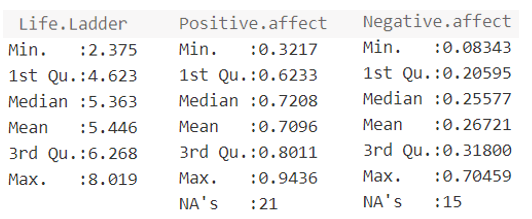
Social indicators
社會指標
In terms of social support, we will analyze two indicators:
在社會支持方面,我們將分析兩個指標:
Social support: it represents the national average of the binary responses (either 0 or 1) to the GWP question “If you were in trouble, do you have relatives or friends you can count on to help you whenever you need them, or not?”
社會支持 :它代表對全球升溫潛能值問題的二元回答(0或1)的全國平均值。 ”
Generosity: it is computed as the residual of regressing the national average of GWP responses to the question “Have you donated money to a charity in the past month?” on GDP per capita.
慷慨 :它是根據全球升溫潛能值對“您在過去一個月是否向慈善機構捐款嗎?”這一問題得到的全國平均值進行回歸而得出的殘差。 人均GDP 。
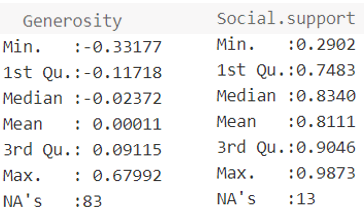
Finally, to grasp the impact of people’s perceptions of politics on their happiness, we will use the following metrics:
最后,為了掌握人們對政治的看法對其幸福感的影響,我們將使用以下指標:
Freedom to make life choices: it represents the national average of binary responses to the GWP question “Are you satisfied or dissatisfied with your freedom to choose what you do with your life?”
可以自由選擇生活 :它代表了全球升溫潛能值問題“ 您對選擇自己的生活的自由感到滿意還是不滿意?”的二元答復的全國平均值。
Perceptions of corruption: it represents the average of binary answers to two GWP questions: “Is corruption widespread throughout the government or not?” and “Is corruption widespread within businesses or not?”
對腐敗的看法 :它代表對兩個全球升溫潛能值問題的二元答案的平均值: “腐敗是否在整個政府中廣泛存在?” 和“ 腐敗在企業內部是否普遍存在? ”
Confidence in national government, constructed with a similar approach.
用類似的方法建立對國家政府的信心 。

Here a quick description of data:
這里是數據的快速描述:
- Years included: 2005–2019 年份包括:2005–2019
- Number of countries: 166 國家數目:166
- Number of regions: 10 地區數:10
2.幸福概述 (2. General Overview of Happiness)
The overall sentiment of happiness is very dependent on the economic conjecture, as one would have expected. In fact, the Life Ladder, which represent people’s own life evaluation, is at its lowest point in the year 2006 just before the financial crisis.
正如人們所期望的那樣,幸福的整體情緒在很大程度上取決于經濟推測 。 實際上,代表人們自己的生活評估的生命階梯處于金融危機之前的2006年最低點。
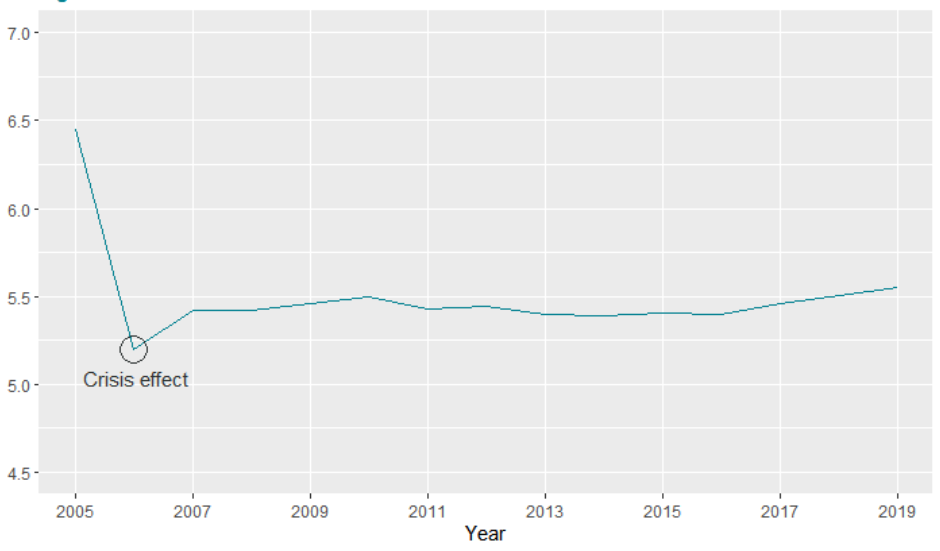
This is also the case of Positive affect and Negative affect. These metrics bring an interesting nuance to the previous one: they refer to the average of previous-day affect in terms of happiness, laughter, and enjoyment or worry, sadness, and anger respectively. Therefore, contrary to Life Lader, there are somewhat short-term measures of happiness.
積極情感和消極情感也是如此。 這些指標給前一個指標帶來了一個有趣的細微差別:它們分別指前一天的平均幸福感,笑聲,愉悅感或憂慮,悲傷和憤怒。 因此,與“ 人生階梯”相反,有一些短期的幸福度量。
In this context, as shown in the graph below, these variables are at the lowest point after the financial crisis as well. However, the impact on Negative affect is certainly stronger than on Positive affect.
在這種情況下,如下圖所示,這些變量也處于金融危機之后的最低點。 但是,對負面影響的影響肯定大于對正面影響的影響。
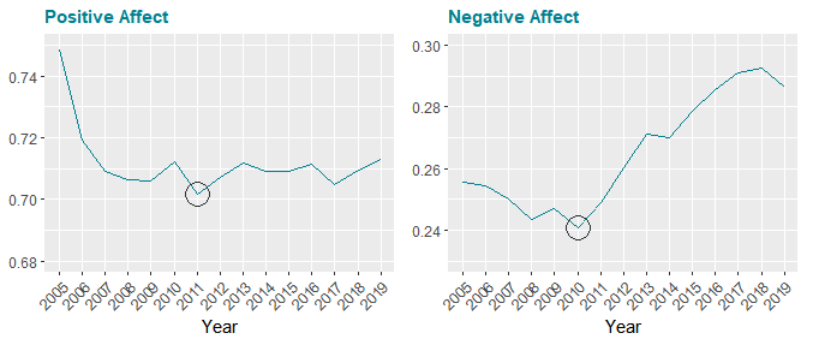
In terms of geographical differences, there is no surprise. Rich countries are on average happier. Most importantly, the graph below shows the tremendous inequalities that exist from a region of the world to another.
就地域差異而言,毫不奇怪。 富裕國家平均而言更加幸福。 最重要的是,下圖顯示了世界某個地區與另一個地區之間存在的巨大不平等。
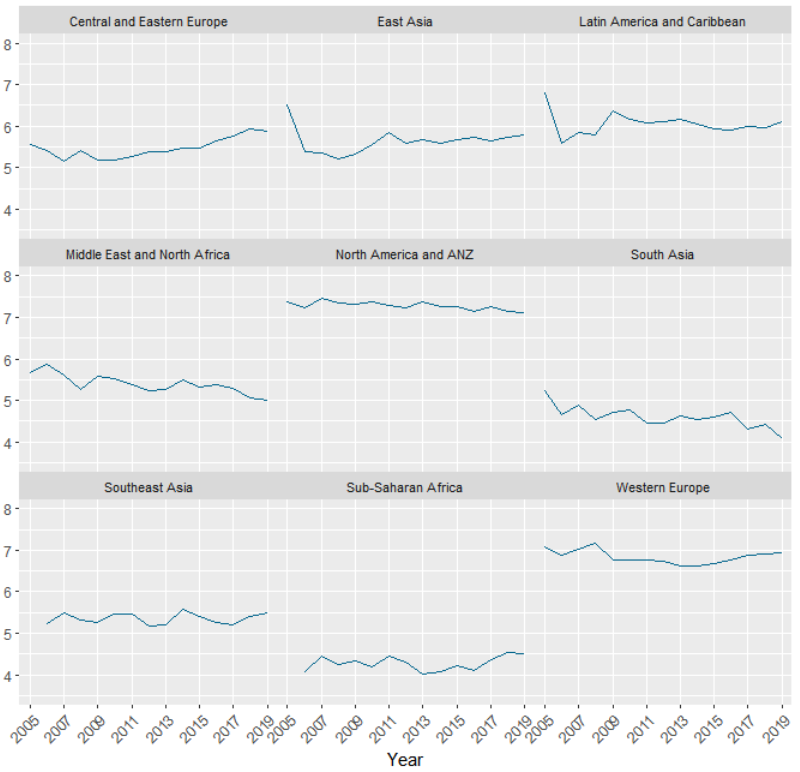
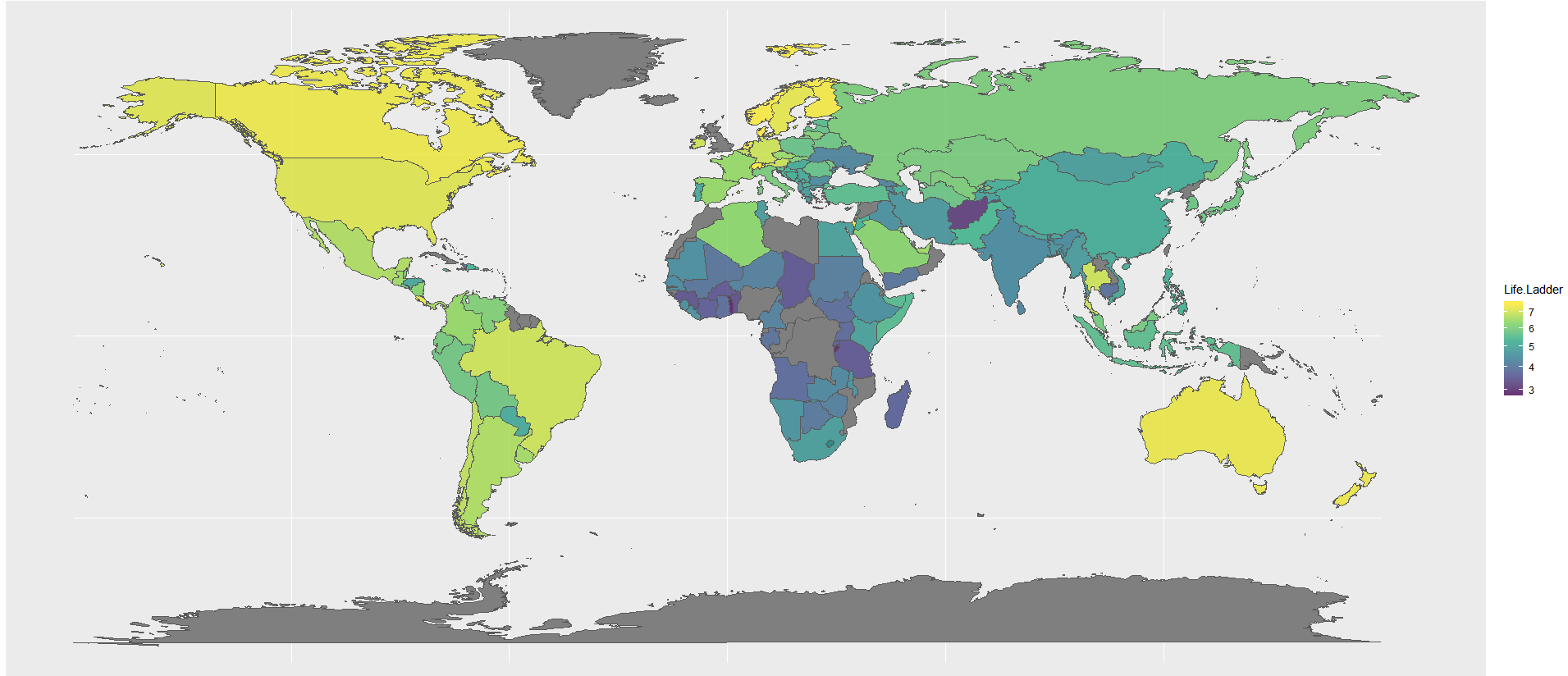
Even within the same region, there are important disparities between countries, especially in South Asia, Middle East, and Africa and Sub-Saharan Africa, as represented in the graph below. On the contrary, happiness levels in countries of North America or Europe are very similar.
如下圖所示,即使在同一地區內,國家之間也存在重要差異,尤其是在南亞 , 中東和非洲以及撒哈拉以南非洲地區 。 相反, 北美或歐洲國家的幸福水平非常相似。
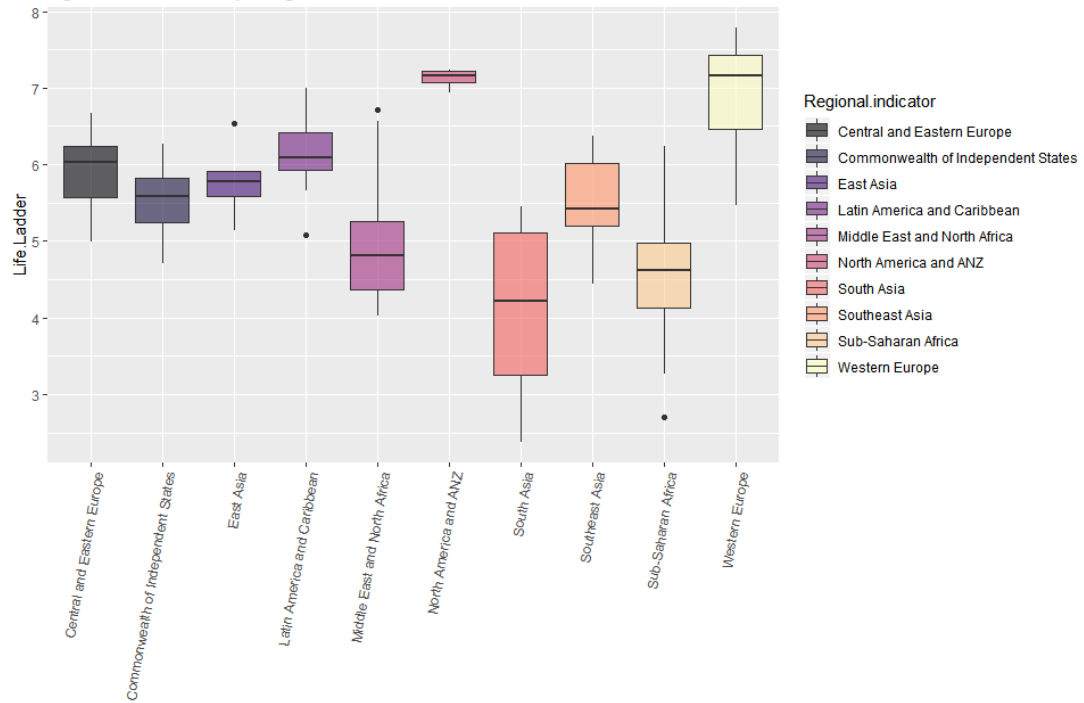
3.幸福與財富 (3. Happiness & Wealth)
For decades, the question of whether more wealth leads to more happiness has absorbed economists, behavioral scientists, and the general public. There is no doubt that people’s happiness and wealth have a strong correlation. And, data do not contradict this general trend. In fact, as shown in the graph, the higher the GDP per capita is, the higher is the happiness level.
幾十年來,經濟學家,行為科學家和普通大眾都開始關注更多的財富是否帶來更多的幸福。 毫無疑問,人們的幸福感和財富有著很強的相關性。 并且,數據并不與這種總體趨勢相矛盾。 實際上,如圖所示, 人均GDP越高,幸福感就越高。

However, there are many exceptions to this rule: the happiness level of countries with a similar GDP per capita can significantly differ. For instance, Norway and Kuwait have similar GDP per capita but their level of happiness differs significantly (1.3 points!).
但是,此規則有很多例外 : 人均GDP相似的國家的幸福水平可能有很大差異。 例如, 挪威和科威特的 人均GDP相似,但幸福感卻相差很大(1.3分!)。

Even within the same region, the level of happiness can differ significantly from a country to another although they have a close GDP per capita. For instance, Finland and Belgium have a similar GDP per capita but their level of happiness differs from 1 point!
即使在同一地區,盡管一個國家的人均GDP接近,幸福水平也可能因國家而異。 例如, 芬蘭和比利時的人均GDP相似,但幸福感卻相差1分!
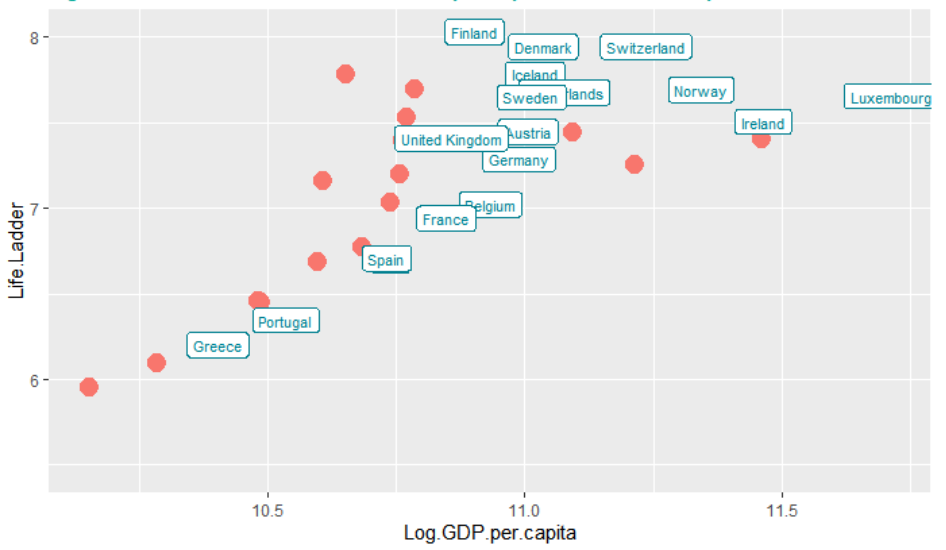
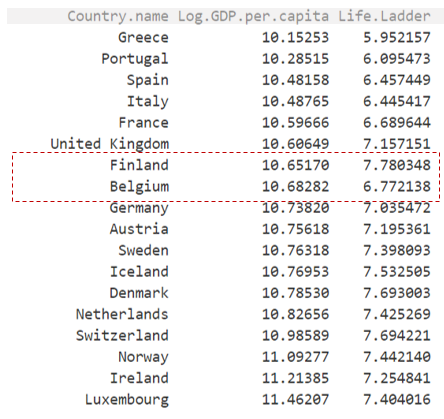
Are these observations a proof of the old cliché “money can’t buy happiness”? Actually, they point to two well-established ideas:
這些觀察是否證明了陳詞濫調“金錢買不到幸福”? 實際上,他們指出了兩個公認的想法:
In general, wealth does matter, but with a diminishing marginal utility pattern. It means that the richer a person is, the less an increase of his wealth would lead to an increase in his happiness.
總的來說,財富固然重要,但邊際效用模式卻在逐漸減少。 這意味著一個人越富有,他的財富增加所帶來的幸福感就越少。
Using wealth as an indicator of happiness is problematic. On the one hand, it can be used to represent people’s willingness to succeed in their work and to improve their standard of living. Thus, people’s wealth would reflect somehow how much people are satisfied with their present lives and hopeful about the future. But, on the other hand, it does not include other variables that have certainly a determinant contribution to people’s life satisfaction, such as family, work, and health.
用財富作為幸福的指標是有問題的 。 一方面,它可以用來代表人們在工作中取得成功并提高生活水平的意愿。 因此,人們的財富將以某種方式反映人們對現在的生活感到滿意并對未來充滿希望。 但是,另一方面, 它不包括其他對人們的生活滿意度具有決定性影響的變量 ,例如家庭,工作和健康。
4.幸福與社會環境 (4. Happiness & Social Environment)
When we think about what the ingredients of happiness would be, it is almost impossible to exclude the social aspect. In fact, as social creatures, we need love, meaning, support from our close relationships with family and friends, and a sense of belonging from our broader networks.
當我們考慮幸福的成分時,幾乎不可能排除社會因素。 實際上,作為社交動物,我們需要與家人和朋友的親密關系中的愛心,意義,支持以及更廣泛的網絡中的歸屬感。
So, is social connection the best path towards happiness?
那么,社交關系是通往幸福的最佳途徑嗎?
Let’s take a look at data. More especially, we will focus on the following variable:
讓我們看一下數據。 更具體地說,我們將重點關注以下變量:
Social support: it measures to what extent a healthy social life can lead to a feeling of security. In fact, a social network is often a source of advice for people and brings them a feeling of comfort in knowing that their family or friends can help them if they ever need assistance.
社會支持 :它衡量健康的社會生活在多大程度上可以帶來安全感。 實際上,社交網絡通常是人們的建議來源,使他們知道自己的家人或朋友可以在需要幫助的情況下為他們帶來安慰。
Generosity: It reflects the feeling of belonging that usually comes from the actions of giving to people and receiving from others.
慷慨 :它反映出一種歸屬感 ,通常來自于給予他人和接受他人的行為。
The table below contains the average per region. In terms of Social Support, North American and Western European countries have the highest value, while South Asian countries have the lowest. In terms of Generosity, North American and Southeast Asian countries have the highest value while Sub-Saharian countries have the lowest. Unsurprisingly, these variables are high when Life Ladder and Positive affect are high and Negative affect low.
下表包含每個區域的平均值 。 在社會支持方面 , 北美和西歐國家的價值最高,而南亞國家的價值最低。 就慷慨而言 , 北美和東南亞國家的價值最高,而撒哈拉以南國家的價值最低。 毫不奇怪,當“ 人生階梯”和“ 正面影響”較高而“ 負面影響”較低時,這些變量較高。

In order to compare the strength of the association between happiness and these “social” variables, let’s compare their correlation. Below are the correlation matrices for two regions, one with a high level of happiness, Western Europe, and the other one with a low value, South Asia.
為了比較幸福與這些“社會”變量之間的關聯強度 ,讓我們比較它們之間的關聯。 以下是兩個地區的相關矩陣,一個地區的幸福度高, 西歐,另一個地區的價值低, 南亞。
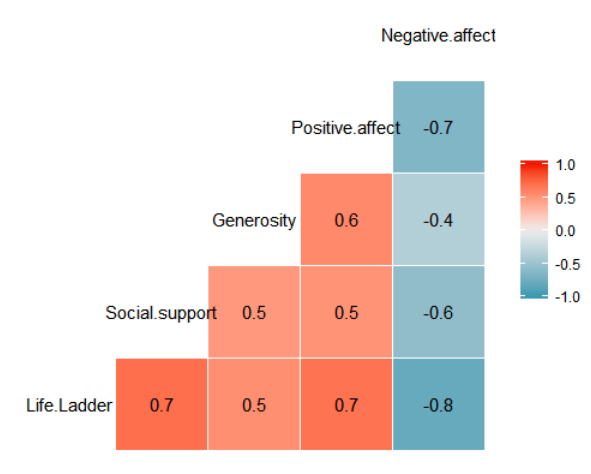

As you can see, while Life Ladder, Positive affect, and Negative affect are highly correlated to Social Support and Generosity in Western Europe, there are not in South Asia. What can we deduce from this? Is it due to the culture of the country, the political system, or other variables? Further study is needed to shed some light on the question.
如您所見,雖然生活階梯 , 積極影響和消極影響與西歐的 社會支持和慷慨程度高度相關,但在南亞卻沒有。 我們可以從中得出什么? 是由于國家文化,政治制度還是其他因素造成的? 需要進一步研究以闡明該問題。
A quick word about the Harvard Study of Adult Development
關于哈佛大學成人發展研究的簡短介紹
In 1938, a group of Harvard researchers investigated the question of the happiness, by tracking the development of a group of teenage boys through periodic interviews and medical checkups. Their objective was to understand the evolution of their health and well-being through time. It became one of the longest and most famous longitudinal studies of its kind. More than 80 years after, the research concluded that social connections are one of the most important factors for people’s happiness and health. As Robert Waldinger, the current director of the study, simply summarized in a famous TED video: “Those who kept warm relationships got to live longer and happier, and the loners often died earlier”. For more information about the study, you can read this article.
1938年,一群哈佛大學的研究人員通過定期的訪談和體檢跟蹤了一群十幾歲男孩的成長,從而研究了幸福問題。 他們的目標是了解他們的健康和福祉隨著時間的演變。 它成為同類研究中最長,最著名的縱向研究之一。 80多年后,研究得出結論, 社交關系是人們幸福和健康的最重要因素之一。 正如現任研究主任羅伯特·瓦爾丁格(Robert Waldinger)在一個著名的TED錄像帶中所概括的那樣:“保持親密關系的人可以活得更長壽,更快樂,而孤獨者通常死得更早”。 有關該研究的更多信息,您可以閱讀本文 。
5.幸福與公共政策 (5. Happiness & Public Policies)
There is no doubt that governments have an impact on people’s well-being, as the public policies they implement define important happiness factors such as access to education, employment, healthcare, etc.
毫無疑問,政府會影響人們的福祉,因為政府實施的公共政策定義了重要的幸福因素,例如獲得教育,就業,醫療保健等。
Actually, the question of the relationship between people’s happiness and the policies put in place by the government is delicate, and this on two levels:
實際上,人們的幸福感與政府制定的政策之間的關系問題是微妙的,這在兩個層面上 :
To what extent a government is entitled to intervene in order to modify the social effects of the market economy? Liberals tend to argue for generous unemployment protections and welfare benefits, while conservatives defend the idea a minimal governmental intervention to ensure market efficiency.
政府有權在多大程度上干預以改變市場經濟的社會影響? 自由主義者傾向于爭取慷慨的失業保護和福利,而保守派則主張這一想法是政府為確保市場效率而進行的最小干預。
How to measure policy impacts? Should we only focus on objective indicators such as national economic growth, per capita production? Or, should we step back and ask, instead, what sorts of public policies lead citizens to evaluate their lives as happier?
如何衡量政策影響? 我們是否應該只關注客觀指標,例如國民經濟增長,人均生產? 或者,我們應該退后一步,問一下,什么樣的公共政策使公民對自己的生活感到更加快樂?
Some countries have historically put happiness in the center of their ideals.
歷史上有些國家把幸福放在理想的中心。
For instance, the American Declaration of Independence lists the Pursuit of Happiness as one of three naturally unalienable rights, alongside Life and Liberty. It also clearly states it as the final goal of any government.
例如,《美國獨立宣言》將“ 追求幸福”與“生命與自由”一并列為三項自然不可剝奪的權利之一 。 它還清楚地指出,這是任何政府的最終目標。
“We hold these truths to be self-evident, that all men are created equal, that they are endowed by their Creator with certain unalienable Rights, that among these are Life, Liberty and the pursuit of Happiness.”Constitution of the United States, 1787
“我們認為這些真理是不言而喻的,所有人都是平等的,創造者賦予他們某些不可剝奪的權利,其中包括生命,自由和追求幸福。”美國憲法, 1787年
The government of Bhutan, a country in South Asia, went a step further by putting aside regular economic indicators and focusing primarily on the Gross National Happiness (GNH), an index that aims at measuring the collective happiness and well-being of the population. Contrary to GDP, its values include harmony with nature and traditional values. For more information, you read this article, and watch this short video.
南亞國家不丹政府進一步拋棄了常規經濟指標,主要關注國民幸福指數(GNH) ,該指數旨在衡量人口的集體幸福感和幸福感。 與GDP相反,它的價值包括與自然和傳統價值的和諧。 有關更多信息,請閱讀本文 ,并觀看此簡短視頻 。
Here, I analyze the impact of people’s perception of the government on their happiness. The following aspects are considered
在這里,我分析了人們對政府的看法對其幸福感的影響。 噸他以下幾個方面考慮
People’s confidence in the government and its policies, through Confidence in the government.
通過對政府的信任,人們對政府及其政策有信心。
People’s perceived level of corruption in the country, via Perceptions of corruption.
通過對腐敗的感知,人們可以看到該國的腐敗程度。
People’s feelings of freedom when it comes to making a life choice, as indicated by Freedom to make life choices.
人們在做出人生選擇時的自由感,正如自由做出人生選擇所表明的那樣。
The efficiency of the healthcare system broadly, reflected by the Healthy life expectancy at birth.
從出生時的健康預期壽命可以廣泛反映出醫療保健系統的效率。
The table below contains the average per region. Countries of Central and Eastern Europe have the lowest value for Confidence in national government and Freedom to make life choices and, the highest Perceptions of corruption, this compared to other countries such as those of North America.
下表包含每個區域的平均值 。 與北美等其他國家相比, 中歐和東歐國家對國家政府和自由做出生活選擇的 信心最低,而對腐敗的觀念也最高。

In order to compare the strength of the association between happiness and these “policies” related variables, let’s compare their correlation. Below are the correlation matrices for two regions, one with a high level of happiness, North America, and the other one with a low value, Central Europe.
為了比較幸福與這些與“政策”相關的變量之間的關聯強度 ,讓我們比較它們之間的關聯。 以下是兩個地區的相關矩陣,一個地區的幸福感高, 北美,另一個地區的價值低, 中歐。
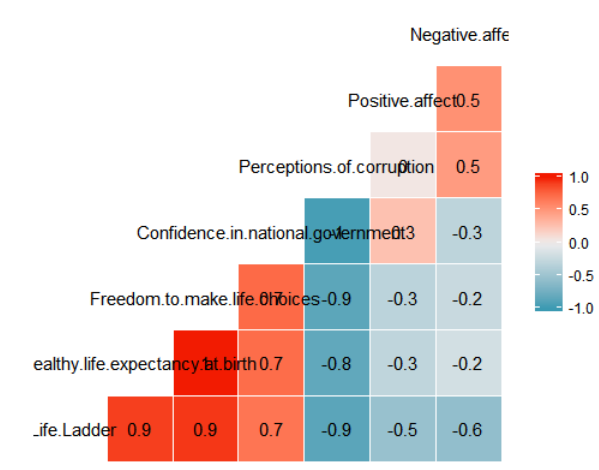
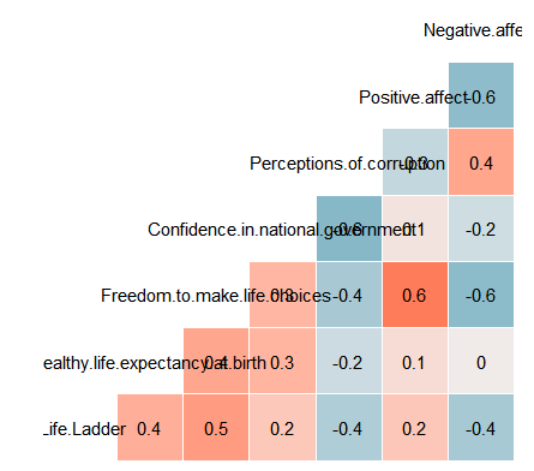
There are 3 elements to notice :
有3個要注意的元素:
First, for countries of North America, Life Ladder has a strong positive correlation to Healthy life expectancy, Freedom to make life choices and, Confidence in national government, and a highly negative correlation to Perceptions of corruption. This is not the case for countries of Central Europe.
首先,對于北美國家/ 地區而言 , 人生階梯與健康的預期壽命 , 自由選擇 生活的 自由度 ,對國家政府的信心和與腐敗的觀念高度負相關。 中歐國家并非如此。
Next, in North American countries, the correlation of these variables to Positive and Negative affects is not as significant as with Life Ladder. This would suggest that these “policies” related variables would have a bigger impact on people's general judgments of life rather than their daily affects.
其次,在北美國家/地區,這些變量與正面和負面影響之間的相關性并不像《 生活階梯》那樣重要。 這表明這些與“政策”相關的變量將對人們的一般生活判斷產生更大的影響,而不是對他們的日常影響產生更大的影響。
Finally, in Central European countries, the correlation between Freedom to make life choices and Positive and Negative affects is significantly high. This would suggest on the contrary that this variable would have a more important impact on people’s daily affects rather than their general judgments of life.
最后,在中歐國家中, 做出生活選擇的自由與積極和消極影響之間的相關性非常高。 相反,這表明該變量將對人們的日常影響而不是對生活的一般判斷產生更重要的影響。
The correlation matrix below shows to extended these difference between developed countries and other countries applies for the other regions of the world:
下面的相關矩陣顯示,要擴大發達國家與其他國家之間的差異,可以適用于世界其他地區:
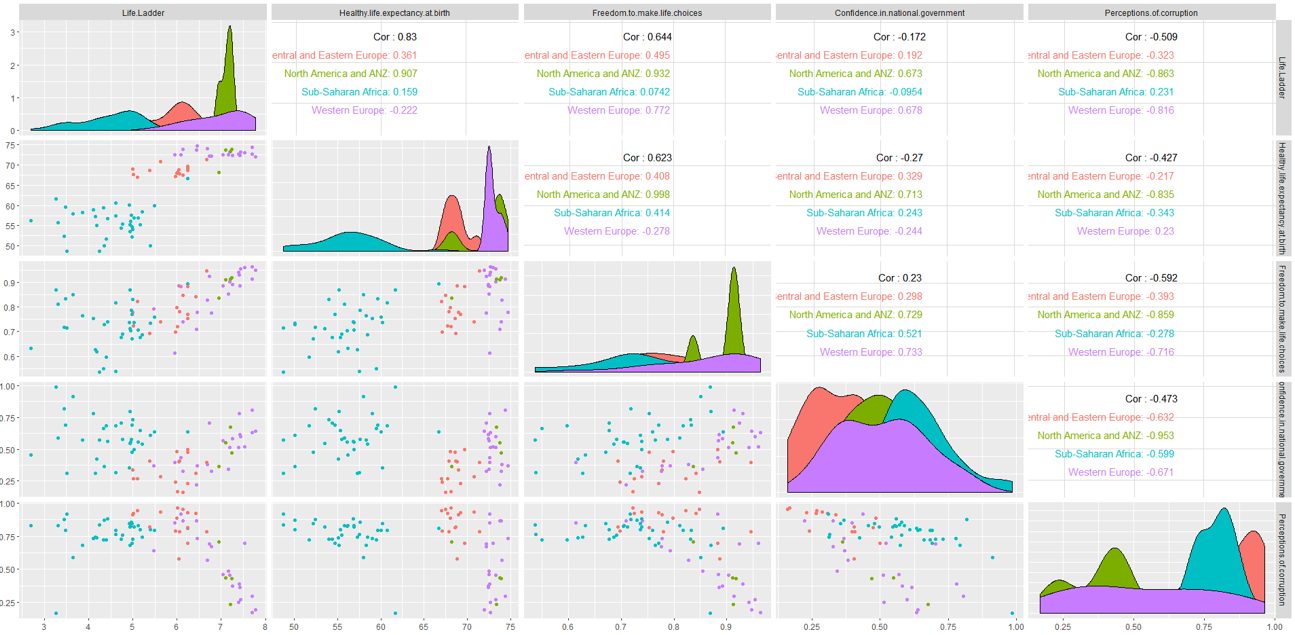
Again, there are 3 elements to note:
同樣,要注意3個元素:
The correlation between Life Ladder and Healthy life expectancy at birth is very high in North America and not significant for Western European countries. This might be explained by the fact that Western European countries usually provide its citizens with solid medical coverage.
生命梯與出生時健康預期壽命之間的相關性在北美非常高,而對西歐國家則不顯著。 西歐國家通常會為其公民提供可靠的醫療保險,這一事實可以解釋這一點。
Freedom to make a life has a significantly higher correlation to Life Ladder in North American countries than in other countries.
與其他國家相比, 北美國家的自由生活與生活階梯的相關性明顯更高。
Confidence in national government and Life Ladder have a high positive correlation in North America and Western Europe where democracy as the political regime tends to be more common. Similarly, Perception of corruption and Life Ladder have a strong negative correlation in North America and Western Europe
在北美和西歐 ,人們對國家政府和人生階梯的 信心具有高度正相關性,而在北美和西歐 ,民主作為政治制度的傾向更為普遍。 同樣,在北美洲和西歐, 對腐敗和人生階梯的 看法也有很強的負相關性
What can we deduce from this? It is hard to conclude anything from these observations since the distribution of the variables varies tremendously form a region to another. However, the correlations above shed light on important facts and present interesting insights to understand happiness dynamics across regions of the world.
我們可以從中得出什么? 從這些觀察中很難得出任何結論,因為變量的分布從一個區域到另一個區域變化很大。 然而,上述相關性揭示了重要事實,并提供了有趣的見解,以了解世界各地幸福的動態。
結論 (Conclusion)
As expected, happiness dynamics are extremely multifaceted varying across countries and through time. However, this complexity should not discourage policymakers from taking them into account. On the contrary, they should use happiness indicators to determine the right policies to implement, but also to measure policies performance. They can rely on the help of experts across the fields of economics, psychology, survey analysis and health to define how measurements of well-being can be used effectively
不出所料,幸福動態在不同國家和時間范圍內都極為復雜。 但是,這種復雜性不應阻止決策者將其考慮在內。 相反,他們應該使用幸福指標來確定要實施的正確政策,而且還要衡量政策績效。 他們可以依靠經濟學,心理學,調查分析和健康領域的專家的幫助來定義如何有效地使用幸福感的測量方法
In this article, I simply carried out a data explanatory analysis so as to get a solid insight into happiness dynamics. In the next, I will focus on the causal relations between happiness and other factors.
在本文中,我僅進行了數據解釋性分析,以便對幸福動態有深入的了解。 接下來,我將重點介紹幸福與其他因素之間的因果關系。
翻譯自: https://towardsdatascience.com/understanding-happiness-dynamics-with-data-part-1-ab58984a715a
天池幸福感的數據處理
本文來自互聯網用戶投稿,該文觀點僅代表作者本人,不代表本站立場。本站僅提供信息存儲空間服務,不擁有所有權,不承擔相關法律責任。 如若轉載,請注明出處:http://www.pswp.cn/news/388674.shtml 繁體地址,請注明出處:http://hk.pswp.cn/news/388674.shtml 英文地址,請注明出處:http://en.pswp.cn/news/388674.shtml
如若內容造成侵權/違法違規/事實不符,請聯系多彩編程網進行投訴反饋email:809451989@qq.com,一經查實,立即刪除!



)








 如何使用C++/CLI讀/寫jpg檔? (.NET) (C++/CLI) (GDI+) (C/C++) (Image Processing))


函數的錯誤消息?)


